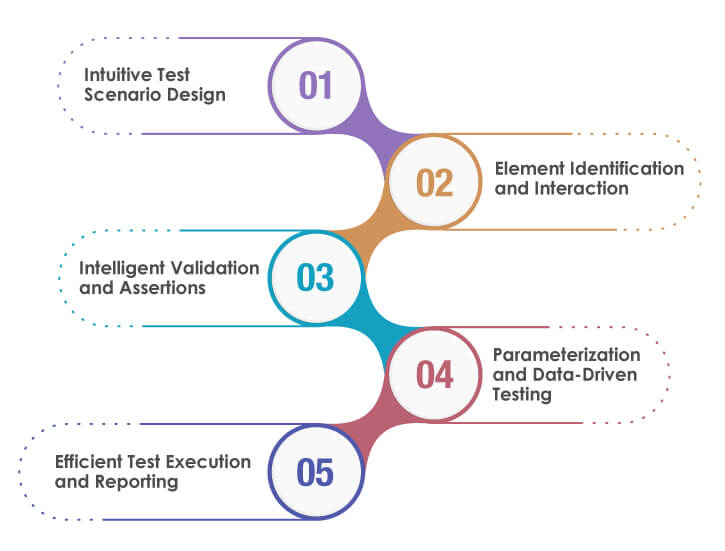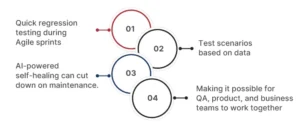Recommended Blogs
Top Codeless Automation Testing Tools for 2025

- What is Codeless Automation Testing
- How does Codeless Automation Testing Work?
- Why Choose a Codeless Automation Platform?
- Significance of Choosing the Right Codeless Automation Testing Tool
- How QA Teams Can Use No-Code Automation?
- List of Features to Look for in a Codeless Test Automation Tools
- Top Codeless Automation Testing Tools
- What to Check When Choosing a Codeless Automation Tool?
- Conclusion
Codeless automation testing is a simpler way to do automation testing as it doesn’t require developing scripts. Creating automation scripts may be quite hard for QA engineers since they have to write code in many different programming languages, which is both hard and time-consuming. You can cut down on testing time by a lot by using codeless automated testing, especially for test cases that need to be run over and over again.
What is Codeless Automation Testing?
Codeless automation testing means creating automated test scripts without writing traditional code. Testers use visual interfaces and drag-and-drop actions to build tests quickly. This approach helps teams speed up test cycles, cut human error, and involve non-programmers in automation. The whole process leads to faster releases and better coverage without needing deep coding skills.
In the era of codeless testing tools available in the market, you’ll find a range of user-friendly features that simplify the testing process. These include:
– Intuitive Drag and Drop Interface.
– Efficient Record and Playback Functionality.
– Seamless Integrations with Machine Learning (ML) or Artificial Intelligence (AI) technologies.
– Reduced Maintenance Efforts.
This approach not only accelerates testing but also ensures that the testing process remains accessible and efficient, even for testers without extensive coding experience.
How does Codeless Automation Testing Work?

No-code or low-code testing, often called codeless automation testing, is the process of leveraging tools and platforms that let people make automated tests without having to write regular code. This method lets testers and non-technical users create and run test cases using a graphical user interface (GUI) or a basic scripting language, so they don’t need to know how to program. As part of modern automation testing services, codeless testing makes things run more smoothly, speeds up the time it takes to get a product to market, and lets more people work on quality assurance without needing to know a lot about technology.
Here’s an overview of how codeless automation testing works:
Intuitive Test Scenario Design:
The first step in codeless automation testing is to develop test scenarios that are easy to comprehend and use. Testers work with a visual interface that usually has drag-and-drop functionalities and a list of pre-made testing actions. The UI is easy to use, so testers can choose activities that mimic how users would interact with the app and put them in the right order to create a logical test flow.
Element Identification and Interaction:
Testers can simply find and interact with parts of the application under test (AUT) using the codeless testing tool. Testers can choose different parts of the user interface, like buttons, input fields, dropdowns, and more, through the graphical interface without having to know how to program. This lets you simulate things that users do, such clicking, entering data, and moving around.
Intelligent Validation and Assertions:
During the creation of test scenarios, testers define validation points and assertions within the test steps. These validation points are critical for verifying the correctness of the application’s behavior. The tool provides predefined validation options and allows testers to set conditions and expectations. Assertions aid in ensuring that the application meets the desired criteria and functions as intended.
Parameterization and Data-Driven Testing:
With codeless automation testing, testers can parameterize, which means they can enter data straight into the test phases. This could be data that was entered by hand or data that was taken from pre-made datasets. Data-driven testing is possible because you may use several sets of test data. This helps make sure the application works correctly with diverse inputs and conditions.
Efficient Test Execution and Reporting:
Testers can start running the automated tests directly from the codeless testing tool after the test cases have been set up and created. The tool runs the test steps that have been set up, interacts with the app according to the given actions, checks the results, and makes thorough reports. These reports provide the status of the tests, how long they took, whether they passed or failed, and any problems that came up. The reports that are made are useful for finding any bugs and giving information about the quality of the program.
Why Choose a Codeless Automation Platform?
Codeless automation technologies aren’t simply useful; they also assist QA teams ship faster, with fewer bugs, and without having to rely on senior automation engineers all the time. You make it less necessary to know how to code while yet allowing business users and manual testers to make a real difference. That’s a huge concern when time is short for deliveries.
They also make feedback loops shorter during sprints, boost coverage with test scenarios that are easy to maintain and let teams work quickly without sacrificing the reliability of the tests. A good codeless platform can grow and develop with you, whether you’re making changes to the UI, building things often, or testing on several platforms.
Significance of Choosing the Right Codeless Automation Testing Tool

Selecting the right codeless automation tool holds immense significance in the realm of software testing and quality assurance. Here’s why making this choice wisely is crucial:
Efficiency and Productivity:
The correct codeless automation tool makes it easier to write and run test cases. It gives testers the tools they need to quickly develop and run tests through easy-to-use interfaces, which saves a lot of time and effort. This increase in efficiency is especially useful in development contexts that move quickly.
Reduced Learning Curve:
Codeless tools are made to be easy to use, so more people on the team can use them, even if they don’t know how to code. This makes it easier for new team members to get up to speed, which saves time and money in the long run.
Cost-Effective:
In the long run, buying the correct codeless automation technology can save you money. It cuts down on the requirement to hire expert automation engineers and the extra work that comes with maintaining traditional scripted automation.
Flexibility and Scalability:
The ideal codeless tool offers flexibility to adapt to evolving testing needs. It should be capable of handling a variety of test scenarios and be scalable to accommodate the growth of your project.
Reliability and Robustness:
Your chosen tool should provide reliable and robust testing capabilities. This means it should support various testing types, handle complex scenarios, and generate dependable test results.
Integration Capabilities:
It is also important that it works with the development and continuous integration/continuous deployment (CI/CD) tools you already have. A good tool fits well into your workflow, making your software development process more efficient overall.
Support and Community:
The availability of a strong user community and reliable customer support for the tool is vital. This ensures that you have resources and assistance readily available when encountering challenges or seeking to optimize your testing processes.
The appropriate codeless automation technology can alter the game by helping your QA team make better products faster, while also making it easier for them to work together and cutting down on the problems that come with traditional script-based automation. It’s a deliberate choice that can have a big positive effect on your software development lifecycle.
How QA Teams Can Use No-Code Automation?
QA teams can employ no-code automation to speed up testing without needing help from developers. Even if they have never written a script, manual testers can make and run test cases using visual interfaces.
These tools are ideal for:
- Quick regression testing during Agile sprints
- Test scenarios based on data
- AI-powered self-healing can cut down on maintenance.
- Making it possible for QA, product, and business teams to work together
List of Features to Look for in a Codeless Test Automation Tools:
Application development firms increasingly embrace codeless test automation tools to keep up with the rapid cadence of new product releases within their CI/CD pipelines. Consequently, they can significantly reduce both the expenses and the time required for repetitive testing, all without the necessity of manual code creation.
In the midst of the continuously rising popularity of codeless test automation, the market boasts an array of over a dozen automated testing tools to consider. Nevertheless, it’s important to discern that not all these tools meet the criteria of being labelled as “genuine” codeless test automation solutions. To help with your selection, here are key features to seek in a codeless test automation tool:
Is it capable of performing resource-intensive and costly tests without requiring proficiency in a specific programming language?
– Does it facilitate application testing on a variety of devices and operating systems?
– Does it offer a straightforward and user-friendly interface, akin to an “Action Logic Editor”?
– Does it come with features for “In-Sprint and Self-healing” capabilities?
– Does it support seamless integration with AI and machine learning technologies?
– Does it offer unified automation capabilities spanning various platforms, encompassing Web and Mobile applications, APIs, Desktop applications, and Mainframes?
Let’s take a closer look at the top five codeless test automation tools available for your testing needs:
Top Codeless Automation Testing Tools
UiPath
UiPath is a top robotic process automation (RPA) platform that has become well-known in the automation world since it is easy to use and doesn’t require any coding. One of the best things about UiPath is that it lets people with little programming experience design and deploy automated workflows quickly and easily. This is known as “low code” or “codeless” automation.
For both beginners and seasoned automation pros, it is a strong tool since it is easy to use, has a large library of activities, and is committed to security and scalability. UiPath lets users automate tasks without having to write a lot of code, which helps businesses run their daily operations more efficiently and productively.
Here are some of the core features of the tool:
– It lets people who don’t know much about coding make automated procedures.
– Gives you a library of pre-made automation tasks for different jobs.
– Make and use your own workflows and activities to make things run more smoothly.
– Has tools for debugging and testing that help find and repair problems in workflows.
– Allows for integration with APIs, databases, and online services to make automation better. Lets businesses start small and grow their automation initiatives as needed.
Katalon Studio
Katalon Studio stands as one of the foremost codeless test automation tools, providing a spectrum of testing capabilities encompassing APIs, web applications, and desktop applications.
This tool is designed for accessibility, catering to both novice and seasoned software testers alike. It boasts a user-friendly interface equipped with features like record and play, along with a drag-and-drop editor. Furthermore, software testers have the flexibility to seamlessly integrate external libraries into Katalon Studio, simplifying test execution without the need to build the framework from the ground up.
Here are some of the core features of the tool:
– Included are pre-designed project templates, test case libraries, and object repositories.
– Enhanced collaboration capabilities for agile teams through integrations with platforms like Slack, GitHub, and others.
– Empowers technical users to craft advanced automation scripts utilizing Selenium or JavaScript.
– Enables the incorporation of native plugins for continuous integration.
– Offers an array of extensive reporting functionalities.
TOSCA
Test Orchestration, Automation, and Reporting” is a full-featured test automation solution that lets you automate tasks without writing any code. Codeless automation is a big change in the field of software testing. It lets testers and quality assurance professionals build and run test automation scenarios without having to write complicated code scripts.
TOSCA is becoming more popular since it makes test automation easier to use and doesn’t require any coding knowledge. This means that more people, including those who aren’t very good at coding, can use it. TOSCA is a codeless automation tool that can help businesses speed up their test automation efforts while relying less on coding knowledge. It has an easy-to-use UI, many ways to connect with other tools, and a focus on reusability, which makes it a good choice for teams who want to automate tests quickly and effectively.
Here are some of the core features of the tool:
– Uses keywords to make it easier to create and manage test cases.
– Promotes the usage of test modules, test cases, and components again to make automation work better.
– Works with a wide range of tools and technologies, such as test management systems and CI/CD pipelines.
– Makes detailed reports on test execution and gives information about test findings.
– Facilitates efficient regression testing to catch and prevent software regressions.
TestIM
Testim is an all-encompassing AI-driven testing platform that assists teams in automating tests with ease, reliability, and collaborative efficiency. Leveraging dynamic and intelligent locators, Testim adeptly adapts to alterations within the Application Under Test (AUT), autonomously generating and executing tests. Furthermore, this platform harnesses the power of machine learning to craft, conduct, and oversee tests, leading to a substantial reduction in the time required for test creation and execution, with the capability to simultaneously perform thousands of tests.
Features:
– Testim’s intelligent and adaptable locators automatically generate tests, simplifying the process of keeping pace with rapid releases and UI modifications for teams.
– It works perfectly with your current CI/CD pipelines and tools for working together.
– Testim’s visual test editors make it easy to create tests for both technical and non-technical team members.
– The platform has detailed test reports and strong bug checkers, which make it easier to do full test analysis.
testRigor
testRigor is a modern codeless testing platform built to support web, mobile, desktop, APIs, email/SMS flows, and more all without writing code. It uses natural language descriptions to create test cases, enabling QA teams to design and maintain tests quickly with minimal overhead.
Features:
-Natural language test creation that reads like plain English
-Self-healing and adaptive to UI changes, reducing maintenance effort
-Parallel execution across browsers and devices
-Integration with CI/CD pipelines and test reporting tools
-Supports real-device testing, performance checks, and complex multi-step flows
Why it fits the list:
As a codeless testing solution, testRigor bridges the gap between no-code accessibility and full-featured automation capabilities. It empowers both testers and non-technical users to contribute, while ensuring robustness in larger scale testing environments.
What to Check When Choosing a Codeless Automation Tool?
Before you choose a codeless automation tool, there are a few factors you must consider:
-Is it really no-code, or is it just a simpler scripting layer?
Once you get past the surface, several tools still need specific coding. Make sure that coding isn’t necessary for the main part of the test creation procedure.
-Can it test across different platforms?
Check to see if your product works with all browsers, mobile devices, APIs, and desktop apps.
-How easy is it to keep up with tests?
Does the tool let tests fix themselves? Can it handle changes to the UI without ruining everything?
-How does test reusability work?
Reusable logic blocks and modular test components cut down on duplication and save time.
-Does it work well with the other tools you already have?
These should all work together without any extra work: CI/CD pipelines, test management systems, and collaboration tools.
-Do you have built-in reporting and analytics?
Dashboards, failure logs, and trend charts help teams find patterns and make sure they test enough.
Conclusion
The world of software testing is evolving swiftly as we get closer to 2026. Codeless automated testing solutions are at the forefront of these changes. These technologies are altering how testing is done, making it easier, faster, and more collaborative for teams in a lot of different professions and industries.
This list has some of the top options, but the perfect tool for your business will depend on things like what your project needs, how skilled your staff is, and how much money you have. So, before you decide, you should look at these tools closely and think about how they will help you reach your testing goals.
Not only are codeless automation technologies making testing easier, but they are also helping to meet the wider goals of getting products to market faster, making sure software is of good quality, and enhancing communication between development and QA teams. By using these technologies in your testing plan, you can make sure that you make high-quality software solutions that match client expectations. This will help your firm stay ahead of the competition in 2025 and beyond.
Should you want any Codeless automation testing services, let’s connect and discuss how TestingXperts can help your business!
FAQs
Codeless automation testing tools allow users to create, execute, and maintain test scripts without writing traditional programming code. These tools use visual interfaces, drag-and-drop workflows, or natural language processing to simplify testing.
They are ideal for QA teams, business analysts, and manual testers who lack programming experience but want to automate repetitive test cases efficiently.
Yes, many modern codeless tools (like Testim, Katalon, and Leapwork) offer advanced capabilities including API testing, AI-powered maintenance, cross-browser testing, and CI/CD integration—comparable to traditional frameworks like Selenium or Cypress.
AI is enabling faster test creation, smart element identification, self-healing tests, and better test coverage suggestions—making codeless tools more robust and scalable.
Top tools include:
1. Testim by Tricentis
2. Katalon Studio
3. Leapwork
4. AccelQ
5. Functionize
6. Tosca by Tricentis
Discover more
Stay Updated
Subscribe for more info

